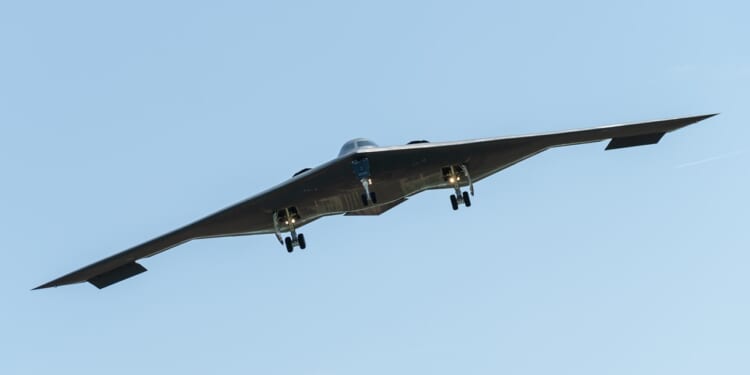A US Air Force general has proposed swapping out one of the B-21 Raider’s pilots for a dedicated weapons systems officer—but there are obvious downsides to the move.
The seven United States Air Force B-2 Spirit bombers that carried out strikes on Iran’s nuclear program in June flew from Whiteman Air Force Base (AFB), Missouri, to the Middle East and back, spending 37 hours in the air. The CONUS-to-CONUS mission was the longest sortie the US Air Force has conducted since it struck targets in Afghanistan following the September 11, 2001, terrorist attacks.
The marathon-length flight was made possible by having two pilots share the workload. While having a pull-down cot, a microwave, a toilet, and a cooler filled with snacks likely added some creature comforts, no doubt the aviators were happy to be on solid ground.
The Northrop Grumman B-21 Raider, now in development and on track to enter service later this decade—eventually replacing the B-2—could offer a similar configuration on the flight deck, with two pilots in the cockpit sharing flight duties. However, the former head of the US Air Force Global Strike Command (AFGSC) had some other ideas.
Putting a WSO in the Second Seat
Instead of having two pilots in the cockpit of the B-21 Raider, some within the Air Force top brass have suggested having one crew member instead serve as a weapons systems officer (WSO). Aviation Week, which had obtained a memo recommending the change, noted it would leave “only one officer with a pilot rating onboard at a time.” The bombers are to be based in the United States and could be deployed on sorties as lengthy as the June mission to Iran and back.
“Air Force Global Strike Command has provided their recommendation regarding the B-21 crew composition to the Headquarters. That document is pre-decisional. A decision has not been made,” Lt. Gen. Scott Pleus, acting vice chief of staff, told Aviation Week.
The memo was written by former AFGSC chief Gen. Thomas Bussiere, who stepped down from that role on November 4. He had submitted his recommendation in August, writing that the B-21’s potential missions could require a WSO on the flight deck.
“Unleashing the Raider’s full potential demands a complex blend of skills: airmanship, weaponeering, electromagnetic spectrum operations, sensor management, real-time battle management and agile replanning in combat,” the memo explained. “For this reason, the B-21 will be crewed by one pilot and one weapon systems officer.”
How Is a WSO Different from a Pilot?
Traditionally, most tactical bomber aircraft have not had a dedicated WSO, instead relying on the pilot to drop ordinance. However, as aircraft systems became more advanced and required a different skill set from flying the plane itself, the Air Force and the Navy began to introduce WSOs to complement the pilot. The first aircraft to feature a WSO was the McDonnell Douglas F-4 Phantom II, which entered service with the United States Navy in 1960. The Navy designated the back seat role as the Radar Intercept Officer (RIO); when the Air Force adopted the concept several years later, it used the term WSO.
The US Navy’s RIOs went on to serve with the Grumman F-14 Tomcat before the term was retired in favor of WSO, which is now used by both services.
Current two-seat aircraft that feature a WSO position include the F-15E Strike Eagle and F-15EX Eagle II, as well as some variants of the F-16D Fighting Falcon and the F/A-18D and F/A-18F Super Hornets. The EA-18G Growler, the electronic warfare (EW) variant of the Super Hornet, has an “Electronic Warfare Officer” (EWO), who performs a comparable role.
It isn’t only fighters that have WSOs in the cockpit. The B-52H Stratofortress and B-1B Lancer bombers each have WSOs; however, it is the pilots who are on the flight deck, with the WSOs seated behind them.
The Raider likely doesn’t have room to add a workstation for a third crewmember, so limiting the aircraft to one pilot—effectively eliminating crews’ ability to trade off flying the aircraft for long-haul flights—could limit how much time it could spend in the air.
That is something Bussiere understands, as he is a former B-1B and B-2 pilot. However, he wrote that it may be necessary given the threats the B-21 could face in future missions.
“The future of airpower will be defined by the ability to project power into the most heavily defended airspace on Earth,” Bussiere added.
Aviation Week suggested a balance could be found. It noted that WSOs are trained to fly the F-15E in “emergency situations,” and WSOs could be similarly trained to operate the B-21 Raider in “certain scenarios.” That could include landing the aircraft if the pilot is unable to do so.
Still, it is still difficult to imagine that one pilot would be able to fly half the distance of a 36-hour round-trip flight without some downtime and still be ready to face the variety of threats that Bussiere suggests. In such a scenario, pilot fatigue might be far worse for the B-21’s safety and mission effectiveness than lacking a WSO.
This may be a subtle way of acknowledging that marathon flights aren’t the future of the B-21 Raider.
About the Author: Peter Suciu
Peter Suciu has contributed over 3,200 published pieces to more than four dozen magazines and websites over a 30-year career in journalism. He regularly writes about military hardware, firearms history, cybersecurity, politics, and international affairs. Peter is also a contributing writer for Forbes and Clearance Jobs. He is based in Michigan. You can follow him on Twitter: @PeterSuciu. You can email the author: [email protected].
Image: Shutterstock / rikinik.
















